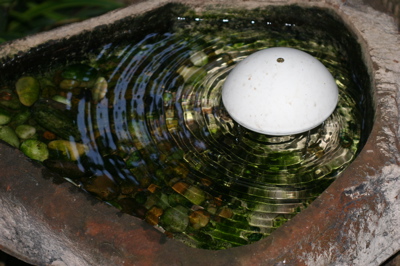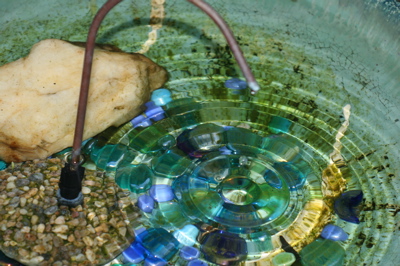-
heated bird baths…well worth the effort!
Frigid winters can be a tough time for wildlife…survival of the fittest is nature’s rule.
Not only do natural food sources dwindle, but shallow pools and ponds tend to freeze, leaving birds and other wildlife without a consistent water source. Some folks believe birds can just east snow to get water, and in part that’s true. But it takes them a tremendous amount of energy to actually convert the snow to water. Energy that could be better spent on staying warm. Birds, like other beings, obtain energy from calories, so this process ends up being a terrible waste of precious calories for wild birds’ metabolisms.
Offering heated bird baths will encourage some species to over-winter in your yard and immediate area. Bluebirds especially, will stick around if heated bath water is readily available. Ground baths are also a great idea, because birds’ naturally bathe at ground level. These heated bird baths can also be quite enticing for other wildlife too.
Innovative birdbath heaters will allow you to convert your favorite bath into a heated one. New materials that are safe for all types of birdbaths make it simple to do so. Even resin, or plastic baths can utilize these heaters, there are heated mats, resin-cased heaters and the very cool Heated Rock.
This winter, consider adding heated bird baths to your landscape, or purchasing a bath heater for your existing birdbath. You’ll help feathered friends thrive and flourish during frigid temperatures, plus catch some quality bird-watching time!
- Bird Accessories, Bird Bath, Bird Baths, Birdbaths, Heated Bird Bath, Pedestal Bird Bath, Uncategorized
Quick Preparations are like a face lift for bird baths
Georgia weather can be so finicky, we usually get cheated out of any decent spring and fall weather. With the last few days in the 70’s and nights around 50 degrees, a cold snap is headed our way. Predicted low temperatures are below freezing starting tomorrow night, until of course, we are back in the 70’s again next week.
There are several bird baths in the yard, (no – make that too many bird baths in the yard) that won’t fare well in freezing temperatures. The concrete pedestal bath for one, along with the ceramic pedestal bath will definitely crack. The plastic ground bath with the dripper will do the same.
I never really understood how folks could just dump the water and turn their bird baths over for winter? Fresh water is a critical element for birds’ winter survival. When temperatures drop below freezing, most shallow pools and ponds tend to freeze, leaving many wild birds no immediate water source.
In lieu of the nearing cold snap, tomorrow’s chores include winter preparations for feathered friends, almost a bird bath face lift if you will. Removing summer bath
accessories like water wigglers (shown above) and drippers like this one, and adding heaters to the baths will keep birds flocking and happy! The deck-mounted bath conceals its heater inside, so it just needs to be plugged in…yay!
Adding heaters to your existing bird baths is one of the best ways to keep birds around. Last year our Eastern Bluebirds over-wintered, staying around through one of the nastiest winters on record.
Help feathered friends to thrive and flourish during frigid winter weather by creating a wildlife-friendly habitat with a consistent fresh water source, food and shelter.
-
nesting materials for winter?
The hobby of attracting birds to our backyards offers varied and interesting methods in doing so. Protocol tells us to offer birds nesting materials in spring…because this is when nature tells them it’s time to mate and build nests. And this is another great way to entice and encourage birds to take up residence, especially due to the severe shortage in nesting sites. But many birds will use cotton and other materials to line roosting spots and nest boxes for cold winter nights as well.
This cotton nesting ball is wildly popular among Goldfinches, and since they’re more likely to stick around if you feed thistle seed throughout the year, you can help them further with nesting materials to keep warm at night.
Some popular nesting materials include cotton yarns and fibers, mosses that are used for decorative aspects in plants and flowers, feathers, aspen fiber and even dryer lint and pet hair are popular materials used in nest building.
This decorative wreath contains a mixture of nest materials that will entice and attract wild birds to your place. Refills are available, and it can be used year-round. Of course landscape plays an important role too. Preferably some mature trees, or dense shrubs like evergreens, and thickets will provide the perfect spots for your feathered friends to nest and raise their families. Don’t forget the fresh water too, as a birdbath will likely be the most popular spot in the yard!






